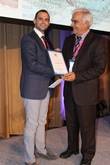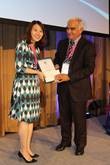Young Scientist Award Competition
Who is eligible to enter?
Young Physicians, Scientists & Researchers born in 1982 or after.
What is this competition all about?
The Scientific Committee of the COGI Amsterdam Congress invites young physicians, scientists and researchers to submit their work and to join the Young Scientist Award competition.
The winning abstracts will receive free registration and the abstracts will be presented as oral presentations.
The next runner ups will receive a 100 Euro discount on registration.
Wow! How do I enter?
It’s very simple.
1. Submit your abstract via the Congress website (Abstract) no later than August 31, 2016.
2. Register and pay registration fees (If your abstract is selected as one of the winners, your full registration fees will be refunded).
3. Include your date of birth during the registration process.
Great! So what are the guidelines for submitting?
- Submitters must be born in 1982 or after at the time of submission.
- Submitters must be the first author of the abstract.
- Submitters must register and pay registration fees by TBA.
- Attendance at the Congress by the winner is mandatory in order to receive and collect the award.
- Winners who cancel for any reason will not be entitled to collect their award.
- Only the winner can claim their award on site at the Congress.
Note that abstracts sent by email or fax will automatically be rejected.
Winners from the “Under 34 Competition” at COGI Budapest 2015
| 1st Place | |
 |
Ulken Tunga Babaoglu, Turkey Assessment of the knowledge level of students of department of nursing about HIV/AIDS and attitudes toward it |
| 2nd Place | |
 |
Jae Young Kwack, Korea Advanced techniques for laparoscopic adenomyomectomy: A transient occlusion of Uterine Arteries (TOUA) |
 |
Sofoklis George Stavrou, Greece Partial molar pregnancy diagnosed histologically after emergency total abdominal hysterectomy in a 51 year old woman and a preoperative diagnostic dilemma. A case report and review of the literature |
 |
Jorge Martinez, Spain Deep endometriosis simulating bone malignant infiltration |
 |
Mădălin-Marius Margan, Romania Lymphatic microvessel density and podoplanin expression in ovarian cancer as potential targets for antitumor therapy |
| Yoshiya Miyahara, Japan Adenocarcinoma represents the most frequent pathological type among giant ovarian tumors weighing more than 5,000G |
|
| Pei Yi Chou, Chinese Taipei Dengue fever may cause oligoasthenoteratozoospermia. A case report |
|
